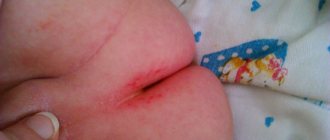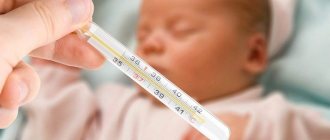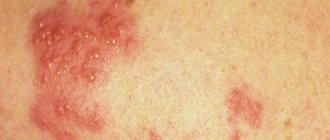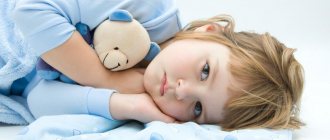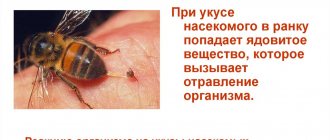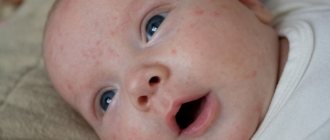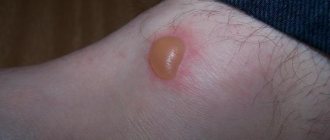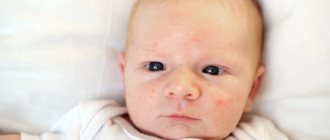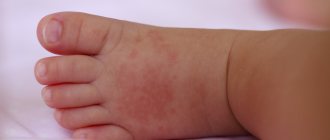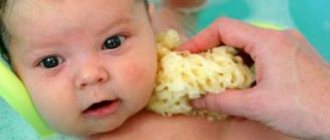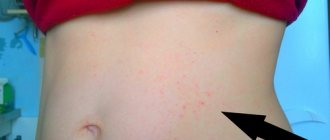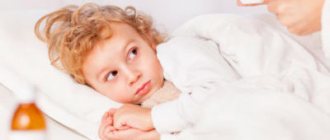Types and nature of the rash
Rash on the back - red spots, pimples, pimples, bumps, watery blisters, pink blisters, pustules. They can be localized only on the shoulder blades, for example, or involve the entire back.
The color of the rash varies from pale pink to red and brown. They may be accompanied by itching, but not always.
A rash on the lower back of a child has age-related characteristics and is conventionally divided into rashes in newborns, children under one year old and after one year. Each disease has its own manifestations, and they may not be related to each other.
Small
It can be a manifestation of a number of diseases that occur immediately after childbirth. A small rash on a child’s back usually does not bother him. 20% of all newborns develop neonatal pustulosis. This pathology is non-contagious and occurs only in the first days of life.
Another minor rash is miliaria. It requires only hygiene procedures and regular changes of clothes made from natural fabrics. Pathology indicates a violation of thermoregulation. Subsequently appears due to skin irritation.
Causes
A rash on a child’s back can occur as a result of a huge variety of different causative factors.
A healthy baby's skin is pale pink in color and there are no rashes on it. If parents notice the appearance of a rash on the baby’s skin, they should definitely show the child to the doctor. The doctor will be able to establish the correct diagnosis and prescribe appropriate treatment.
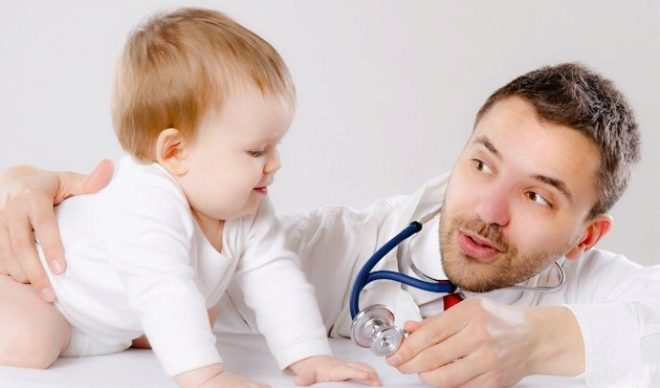
A rash on the skin of the back can appear at any age. The reasons that cause its appearance in newborn babies may differ markedly from those that contribute to the development of skin rashes in teenage children.
Quite often, various allergic pathologies lead to the development of rashes on the back and neck in children. They occur in children who have an individual predisposition to exposure to various allergens.
Atopic dermatitis is manifested by the appearance of skin rashes on the back, shoulders and abdomen. This condition occurs as a result of exposure to allergens of plant, animal or chemical origin. The appearance of the rash is preceded by severe itching and excessive dryness of the skin.
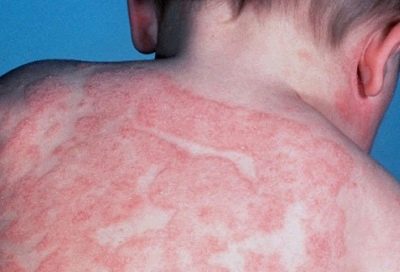
Atopic dermatitis in young children is quite often a consequence of the use of low-quality children's cosmetics used for daily hygiene procedures.
In the youngest patients, miliaria causes red or white rashes to appear on the back. This condition occurs due to excessive wrapping of the child in warm clothes.
The imperfect functioning of the thermoregulatory system of the child’s body contributes to rapid overheating after a fairly short period of time. The symptoms manifest themselves most clearly in babies in the first months of life.
Specific childhood infections are, perhaps, quite common causes of the appearance of various types of skin rashes in babies.
Chicken pox is accompanied by the development of rashes that are localized on the skin of the back, as well as on other parts of the body of the sick child. The appearance of skin rashes is preceded by an incubation period, during which practically nothing bothers the baby. Chickenpox is much more severe in schoolchildren than in children attending kindergarten.
READ ALSO: Tavegil - Rashes (rashes)
Rubella is one of the infectious pathologies that also develops quite often in children. Children who have not had previous vaccinations are at increased risk.
Children attending children's educational institutions are more likely to become infected. The classic manifestation of rubella is the appearance of a bright rash that is localized on the back, as well as on many other parts of the body.
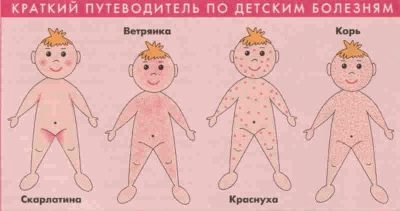
Bacterial infections quite often cause signs of vesiculopustulosis to appear on the skin of a sick baby. These skin rashes look like numerous blisters containing pus.
The course of the disease is usually severe. In some cases, purulent formations may open, and the pus present in them flows out, forming ulcers on the skin. To eliminate adverse symptoms in this case, the use of antibiotics is required.
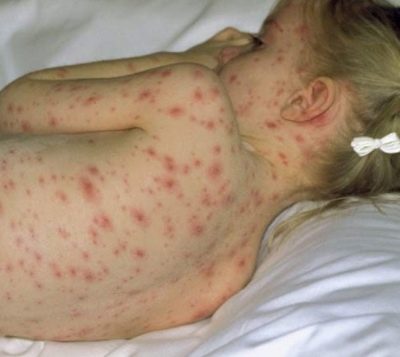
It's not just bacteria that causes rashes. Fungal flora is also quite often the root cause of the appearance of a specific rash on the skin. It can be localized in various parts of the child’s body, including on the back.
Such elements look like scaly neoplasms that can itch, thereby bringing severe discomfort to the child. To eliminate adverse symptoms, long-term administration of antifungal and immunostimulating drugs is required.
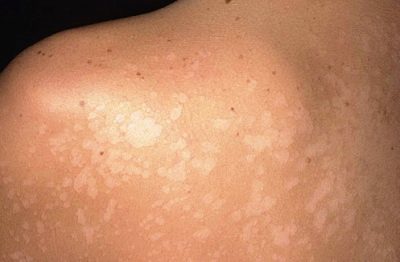
Diseases of the internal organs are the “silent” cause of the appearance of characteristic rashes on a child’s skin. The appearance of formations on the skin is quite common in endocrine pathologies. Children with diabetes or severe metabolic disorders are at increased risk.
Changes in the functioning of the reproductive organs also lead to the appearance of various pimples or even pustules on the child’s skin. This most often occurs during puberty.
Scientists believe that an increase in testosterone levels leads to the development of such purulent elements on the back of adolescents. According to statistics, such skin rashes are more common in boys.
The explanation for this is the physiologically initial high level of testosterone in the male body.
Measles infection is also a very common cause, which leads to the appearance of various skin rashes on the healthy and clean skin of the baby.
READ ALSO: Rash during ARVI, what types and causes there are
Most often, children of preschool age get sick with this infectious disease. The high-risk group includes babies who have not previously been sick, as well as babies who, for some reason, do not have up-to-date vaccinations.
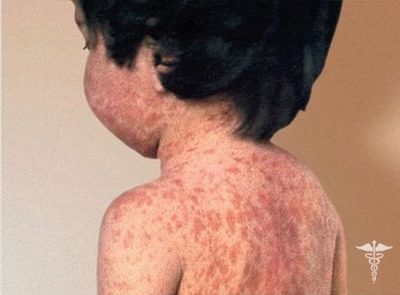
Sudden exanthema is a viral pathology that causes various rashes on the child’s skin. Scientists have found that the cause of this pathology is the effect of herpes viruses of subtype 6 on the body. The predominant localization of the rash with this infection is on the chest and back. Sudden exanthema, according to statistics, more often occurs in children with signs of immunodeficiency.
Scarlet fever can also cause characteristic rashes to appear on a child's skin. In some cases, a rash due to this infection may appear on the baby’s back. Usually the disease is quite severe with severe symptoms of intoxication.
Other factors
Why does a child develop a rash on his back? The causes may be parasitic pathologies, for example, scabies.
Disruption of the gastrointestinal tract can also cause rashes. The reason may be:
- psoriasis, Lyme disease, herpes, syphilis;
- hormonal changes during puberty (more often occurs in boys and depends on increased levels of testosterone in the blood);
- neurodermatitis;
- diabetes;
- rash after massage;
- meningitis;
- insect bites.
READ ALSO: Rash in a child (photo): rash on the face, on the body, causes of the rash - NaPopravku
A rash on the lower back of a child can occur when the immune system is weakened. The reasons are physical and mental overstrain in the student, poor nutrition, and lack of sleep. A reaction to increased ultraviolet radiation in children in the form of a rash on the lower back is rare.
Rash in children under one year of age
The most common problems parents face are:
- allergy;
- diaper rash;
- prickly heat;
- neonatal pustulosis;
- acne of newborns.
The last 2 points are not diseases, but manifestations of physiology, and they do not require treatment, they disappear on their own. They are associated with the influence of maternal hormones.
Allergic dermatitis, eczema and psoriasis are practically never found in newborns.
An allergic rash is a condition that can appear instantly, in less than a day. Before 3 months, hereditary predisposition to allergies does not appear. In infants, allergies are often associated with the introduction of complementary foods and improper nutrition of the baby's mother.
If during sleep a child sleeps on woolen blankets, feather beds, wears clothes made of artificial fiber, or his clothes are washed with cheap and low-quality powders, allergic dermatitis may appear. Therefore, you should be careful when choosing funds. It is necessary to select a blanket, pillow, and mattress for your baby with special care.
Diaper rash appears where the skin most often comes into contact with rough tissue, feces or urine. This condition is called diaper dermatitis and causes a rash on the baby's lower back. Skin lesions appear first on the butt, then on the back and abdomen. With a large area of damage, the child becomes restless, constantly cries, and refuses to breastfeed.
A rash on the lower back of a one-year-old child is often caused by prickly heat. It can be local or appear in many places in the body at once.
The rash is small, in the form of reddish nodules, and can be on the child’s back, neck, or chest.
The temperature does not rise, the child’s mood does not change, and his appetite does not disappear. Treatment and causes of rash on a child’s back are interrelated.
Causes of small rashes on the body
A small red rash all over the body, this may be miliaria, it occurs in very hot weather.
In children, sweating increases and the sebaceous glands do not cope with their function. Miliaria does not require special treatment; it is necessary to bathe the baby more often in infusions of medicinal herbs.
Body rashes in children are quite common. But there are many infectious diseases whose symptoms are skin rashes. Therefore, it is very important to diagnose the disease in time to prevent complications and spread of the disease.
If chickenpox is detected, then special treatment is necessary, most often using brilliant green or other antiseptics.
When rashes appear in children, especially under one year of age, self-medication is highly discouraged. The child’s internal organs and systems are not fully formed.
Children, due to their age, are not able to describe their sensations (pain, dizziness). Conventional therapy methods used for adults are not suitable for small patients. All this complicates the choice of adequate therapy even for a specialist.
Before examination and treatment by a pediatrician, adequate hygiene must be ensured. Wear spacious clothes made from natural fabrics. If your son or daughter tries to scratch pimples, make sure their nails are trimmed and their hands are clean. It is important to monitor the condition, measure the temperature, assess the frequency and nature of stool.
For allergies
With urticaria, first of all, pathogenetic factors (food, inhalation and others) are eliminated.
The specificity of therapy depends on the nature of the course and etiology of the disease:
- In acute and chronic cases, antihistamines (Clemastine, Fenkarol) are prescribed.
- Itching is relieved with sedatives and calcium supplements.
- When allergies develop against the background of an infectious process, antibiotics, antiviral, and anthelmintic drugs are used.
- General UV therapy helps alleviate urticaria.
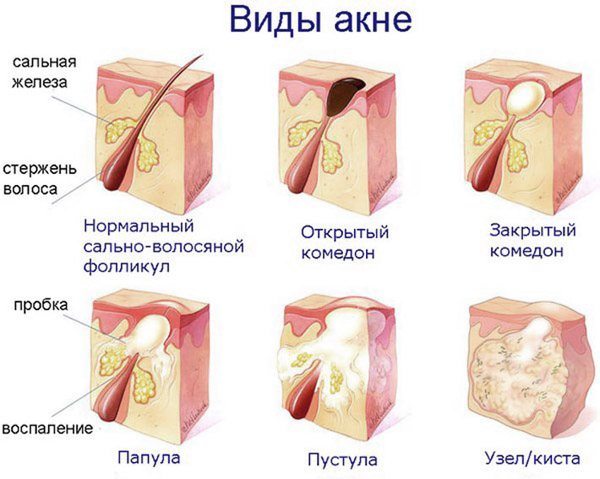
Pimples on the forehead in women: causes of their appearance and the best ways to deal with the problem
All these diseases in most cases are not accompanied by fever. But 99% of the time there is a rash
. And parents shouldn't panic. A child’s rash all over the body without fever is just the child’s body’s response to the virus inside it.
What is the correct behavior of parents in this case? First of all, don't panic
; secondly, immediately call a doctor for an examination; thirdly, it is imperative to monitor the child’s condition in the future and transfer everything to a specialist. And lastly, strictly follow all prescribed instructions from your doctor.
Treatment for such a rash is prescribed by a specialist, based on the root cause of its appearance.
There are many reasons why pimples appear on the back, stomach, arms, legs and other parts of the body. They can be divided into three large groups:
- allergic reaction;
- diseases of a viral or bacteriological nature;
- pathological processes on the skin caused by external factors.
As for negative external influences, the most common types of skin manifestations should be noted:
- Prickly heat. The location of small red pimples is the back, neck, armpits, and groin. Most often occurs in one-year-old infants due to severe sweating, irritation from urine, loose stools, and diapers. Usually it appears only in the form of small pimples.
- Insect bites. Such pimples are not a threat to the child's health unless he has allergies.
- Scabies. It is caused by the scabies mite. Characteristic red nodules appear on the hands and feet between the fingers, around the wrists, on the shoulders and forearms. This rash is very itchy and causes great discomfort.
We invite you to familiarize yourself with 22 tricks for prolonging a man’s sexual intercourse using pills, drugs and various techniques
The appearance of a rash is often allergic in nature. The rash is usually accompanied by itching. If the child is small, then he will let you know about the discomfort that has arisen by crying.
The rash can be a symptom of: rubella, erythema toxicum, scabies. Or is it the initial stage of chickenpox. When there are problems with blood vessels and clotting, red spots may appear on the body. When they appear, you need to take into account: has the child eaten a new product, has there been a change in powder or brand of diapers. Maybe there was a fever or vomiting before this.
The disease can be identified by the accompanying symptoms. The pediatrician makes the final diagnosis. Even if it is just an allergy, consultation is necessary. You need to find out the type of allergy (food or contact). The disease is dangerous because it is unknown how the body behaves from the inside.
Rashes on the back in children after one year
After a year, the child’s contacts with the outside world expand noticeably; older children go to kindergarten and school. In this age group, the appearance of a rash is of epidemic importance because infections occur.
At this age, we can conditionally distinguish 2 largest groups of causes: infections and allergies.
Children's infections are measles, rubella, chickenpox, scarlet fever. A rash on the back with them is a mandatory symptom. These diseases are almost always accompanied by fever, poor general condition, and intoxication. They are contagious, so quarantine is necessary.
What does it look like?
Rashes on the back can vary in appearance. Most infectious pathologies manifest as a red rash. Usually the skin elements are very itchy and significantly worsen the child’s well-being. In some cases, a colorless rash also occurs, but this condition is registered in children relatively less frequently.
White or reddish skin lesions that appear on the back and neck may be a manifestation of miliaria. Usually this condition is caused by a violation of thermoregulation and manifests itself in the youngest children.
Wearing warm clothes in a fairly hot season disrupts the heat exchange of the skin, which leads to the development of excessive sweating in the baby. Ultimately, this causes the appearance of fairly large rashes that are localized on the baby’s back and chest.
Fungal rashes appear as multiple formations, which can have a variety of sizes. In some cases, these elements merge with each other, forming areas with very unusual shapes and outlines.
of lichen lead to the development of skin rashes . After cleansing the skin of such elements, white areas remain on it, which do not tan well when exposed to sunlight. Skin rashes of fungal etiology usually cause severe itching in the child, which brings severe suffering to the baby.
READ ALSO: Furuncle: photo, how to treat, causes
purulent blisters may form on the skin . Typically, this condition is registered in children between 10 and 15 years of age. The size of such rashes usually does not exceed a few millimeters.
Careless contact can lead to the leakage of pus from such a vesicle and the penetration of a secondary bacterial infection into the cavity. In this case, the course of the disease worsens significantly.
Diseases
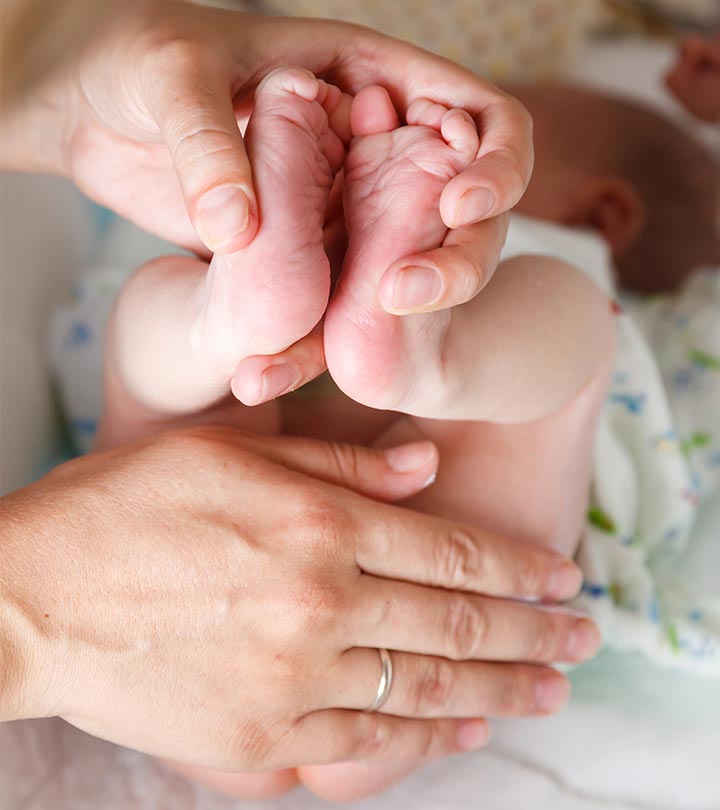
The simplest and most harmless rash on the lower back of a child is prickly heat. It occurs not only on the back, but also in the folds of the skin, the back of the head, the shoulders, i.e. where there are a lot of sweat glands. It is the result of a violation of thermoregulation, which is imperfect in a small child.
The baby's body overheats, and a small, pinpoint rash with itching appears. Its treatment is also very simple. You should bathe your child in a decoction of string, calendula or chamomile. Then you need to get the baby wet and treat the skin with a drying agent, such as talc or powder. At the end, the child is changed into lighter natural clothes so that the skin can breathe. These measures are usually sufficient.
READ ALSO: For blackheads - a review of the best Korean cosmetics products of 2020 ⚡
With vesiculopustulosis or pyoderma, a small pustular rash appears. It can be not only on the back.
Rubella is a viral infection. Rashes in the form of small pink spots. Body temperature may rise slightly and catarrhal symptoms appear.
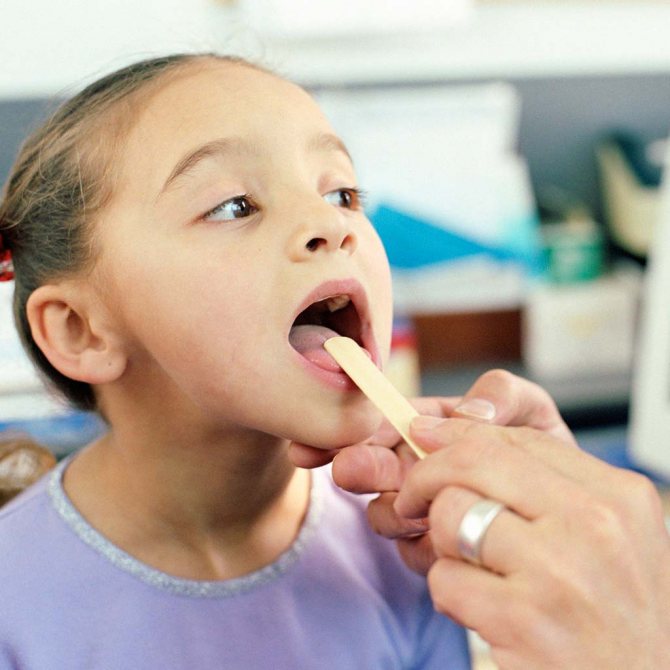
Scarlet fever is caused by hemolytic streptococcus and is contagious. A small pink rash appears on the child’s lower back. A characteristic sign is that from 2-4 days of illness the tongue becomes bright crimson. Fever, intoxication and signs of sore throat are also noted. The diagnosis, according to doctors, can be made even in the dark: just run your hand over the skin: the scarlet fever rash resembles fine sandpaper.
Chicken pox is caused by herpes type 3. Colorless blisters with liquid appear on the skin, and sometimes they can itch. Then, after some time, the bubbles burst, and these places become covered with a crust. The general condition is often not disturbed. Locations are not only on the back, but throughout the body. Those who have recovered from the disease develop lifelong immunity. Otherwise, infection occurs in 100% of cases through contact with a patient.
Ringworm is a fungal infection of the skin. A rash in the form of spots with pimples of pus.
Measles is dangerous for unvaccinated children. On the 5th day of illness, a red-spotted rash appears not only on the back, but also throughout the body. Closer to the feet it decreases. The spots tend to merge. They are preceded by fever (more than 39 degrees), sore throat, cough, runny nose.
Meningitis is a very dangerous meningococcal infection in children. With it, the temperature rises sharply, the state of health worsens, vomiting appears, and consciousness is impaired. Rash in the form of small hemorrhages. Meningeal symptoms are manifested in the stiffness of the neck muscles - when bending the chin, the legs move, etc. Meningitis requires urgent hospitalization.
Roseola or sudden exanthema is caused by herpes type 6. It occurs suddenly in children with signs of immunodeficiency. The temperature rises sharply above 39 degrees, but the general condition is not disturbed. 5 days after this, the back and chest become covered with a small pink rash. No treatment is required, the rash disappears on its own.
Scabies is caused by the scabies mite. You can become infected with it in any public place. The rash is accompanied by severe itching, which intensifies in the evening. This is due to the activation of the mite, which crawls in the upper layer of the dermis and gnaws its passages. From time to time it creeps out to the surface of the skin. Therefore, this rash seems to be paired - the “entrance” and “exit” are visible.
Allergic rash in children. It occupies a large group of skin lesions on the back. They are collectively called allergic dermatoses.
READ ALSO: Rash due to gastritis with high acidity
Children under the age of 3-4 years most often suffer from atopic dermatitis (diathesis, infantile eczema), strophulus (papular urticaria) and urticaria (acute and chronic), contact dermatitis and exudative erythema.
Allergic dermatosis develops in the form of an abnormal skin reaction both with a single contact with an allergen and with its regular exposure. Single contact leads to acute urticaria and Quincke's edema. Allergens can be very different, they have already been discussed.
Most often, the provocateur is a foreign protein. Usually cow's milk (casein) when introducing complementary foods. Predisposing factors include chronic gastrointestinal disorders, heredity, intestinal dysbiosis, and poor environment.
How to treat red pimples on a child's stomach
There are a lot of parogenetic factors that cause red acne. The skin in childhood is delicate and quickly reacts to internal pathological processes and negative external influences. There are several main causes of the appearance of a rash:
- Allergic reaction. Allergies can be to certain foods, pollen, animal dander, and insect bites.
- Viral and intestinal infections.
- Dermatological diseases.
- Adaptation of the body.
Each group includes different pathologies, often with a similar clinical picture.
The appearance of unpleasant symptoms may be due to improper care. Miliaria - small blisters with transparent contents are a consequence of insufficient hygiene.
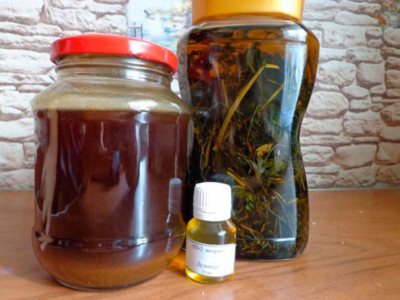
The main locations are the neck, chest, back, and inguinal folds. If miliaria is not treated, there is a high risk of developing vesiculopustulosis. Its first sign is the appearance on the skin of small bright pink or red blisters with serous fluid inside.
One of the common causes of rashes is allergies. An immunopathological reaction usually occurs during the period of introduction of complementary foods. Urticarial rash (urticaria) appears in the form of blisters and is accompanied by itching. They are observed throughout the body, the first rash disappears within 2 hours, then a secondary rash appears, which is more stable.
Signs about pimples on and near the lips
Streptoderma is a whole group of streptococcal infections.
Phlycten - blisters with serous contents are observed on the face, hands and other open areas of the skin. The development of the disease is preceded by abrasions, wounds, and insect bites. Through them, streptococci penetrate inside, causing infection. Pathogens are transmitted by contact - through kissing, sharing utensils, etc.
There are several main reasons for acne in children:
- allergic rashes;
- infectious nature of acne;
- rashes of a different nature.
Appearance
Pimples on the skin of children can appear on various parts of the skin. Their location and appearance may indicate various diseases:
- red pimples on the chin that form spots;
- watery rashes all over the body;
- small rashes on the body;
- large red spots are localized on the back, shoulders and buttocks.
The appearance of watery pimples all over the skin may indicate an infectious disease. Their localization on the back, abdomen, arms and legs signal a viral infection and are a reason to immediately consult a doctor.
Pimples are red in color, with a rough structure, forming groups - this is a sign of an allergy. It can be caused by food, hygiene products and many others. If acne is accompanied by a runny nose and sneezing, then the diagnosis has been made accurately. By eliminating the allergen, the rash will go away on its own.
A small red rash all over the body, this may be miliaria, it occurs in very hot weather. In children, sweating increases and the sebaceous glands do not cope with their function. Miliaria does not require special treatment; it is necessary to bathe the baby more often in infusions of medicinal herbs.
Milia. They go away on their own, but if they become inflamed, you should seek medical help. This happens due to improper care by parents, for example, when squeezing or smearing with inappropriate cream.
Miliaria is a small rash on the butt, armpits, and neck folds.
- open the baby more often for air baths;
- bathe in decoctions of herbs and chamomile;
- change diapers promptly;
- ensure a comfortable room temperature, 18-22 degrees;
- Don't wrap your child up too much.
If you follow these recommendations, the heat rash will soon go away.
Body rashes in children are quite common. But there are many infectious diseases whose symptoms are skin rashes.
Therefore, it is very important to diagnose the disease in time to prevent complications and spread of the disease.
Help with allergies
For allergic rashes, it is necessary to find their cause. If the reason cannot be found out, then it is necessary to reconsider the menu of the nursing mother and the baby itself.
Treatment of acne in a child comes down to the following:
- By using antihistamines you can relieve allergy symptoms. In this case, it is necessary to strictly adhere to the dosages specified in the instructions.
- Next, with the help of sorbents, toxins are removed from the body; for this you can use smecta, enterosgel, etc.
- With the help of probiotics, the functioning of the gastrointestinal tract improves, because dysbiosis very often leads to allergies.
- In severe forms of allergies, hormonal drugs are used, which are prescribed by a doctor.
- If an infectious disease is detected, therapy is as follows:
- If chickenpox is detected, then special treatment is necessary, most often using brilliant green or other antiseptics.
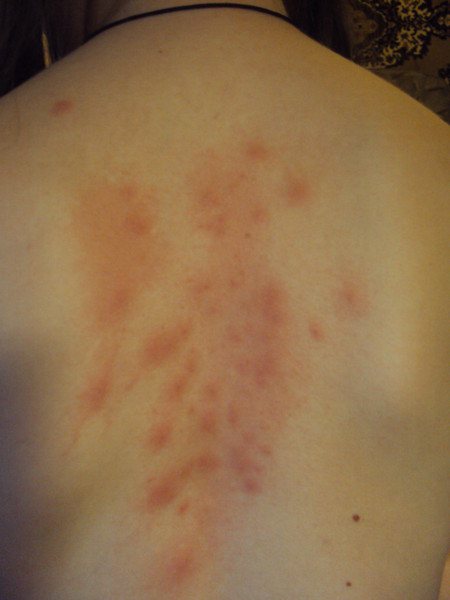
With diseases such as scarlet fever, measles and rubella, the rash goes away on its own within a few days. In case of severe itching, use an antihistamine.
If a child is bothered by insect bites, antihistamines should be used. Lubricate the bite site with antiallergic ointment. Anti-inflammatory absorbable compositions will help well if after the bite there is a permanent mark.
We suggest you read: How to anoint a child’s iron burn
For skin rashes caused by mechanical impact, it is necessary to lubricate the affected area with diaper rash cream; Bepanthen and Desitin are good options.
The rash at the site of sunburn is lubricated with panthenol.
Quite often, parents watch with fear as red pimples break out on their child on various parts of the body, including the face. The first thought is an allergy, although in fact the cause of this phenomenon may be other diseases, on which the prescribed treatment methods and the speed of the baby’s recovery will depend.
On their own, at home, it will be very difficult for parents to determine why red pimples broke out on their child’s body.
If the reason lies in malfunctions and disruptions in the functioning of various systems of a small body, it is better to consult a doctor as soon as possible for a timely diagnosis. Among the factors that provoke the appearance of a rash are:
- teething (accompanied by copious salivation);
- diaper rash;
- reaction to vaccination;
- failure to comply with basic hygiene rules;
- low-quality clothing made from synthetic materials;
- overheating of the skin (if too many things are put on the baby and he becomes hot), resulting in prickly heat (in the hospital, such pimples are called milliaria);
- allergies (it is necessary to identify what the baby reacts to so violently in order to exclude his contact with this object or animal);
- diseases such as scarlet fever (accompanied by fever), chickenpox (fever), measles (a cough is added to the rash);
- streptoderma;
- infectious inflammation of the skin;
- dyshidrosis;
- molluscum contagiosum;
- enterovirus;
- external environmental factors: chapping, sunburn or frostbite, insect bites;
- acneiform rash in infants whose mother took certain medications during pregnancy: steroids, medications with lithium or phenytoin.
If you notice red pimples on your child's face, tummy and other parts of the body, try to understand why this could be happening. If there are no obvious reasons, be sure to seek medical help at the hospital.
Red pimples that appear in a child on the face (most often on the cheeks and around the mouth) and on the body (on the arms and legs, on the butt, on the back, on the stomach) may look different.
For some, they may present as localized lesions that resolve within a few days. In others, they can cover most of the body and over time only grow and become even more inflamed.
These may be rashes such as:
- small pale red pimples on the chin, gradually turning into one continuous inflamed spot - this is due to excessive salivation during teething;
- red, watery pimples on a child’s body can be a symptom of chickenpox: at first, single tumors become more and more numerous;
- pimples on the butt - from diaper rash due to a diaper;
- if a black dot can be seen in the center of the water pimples, molluscum contagiosum will most likely be diagnosed;
- pimples mainly spread exclusively to the arms (palms) and legs (feet) of the baby and appear in the off-season (spring and autumn) - we are talking about dyshidrosis;
- a pink-red spot, which after a few hours turns into watery pimples, is a sign of streptoderma;
- small red pimples on a child’s body are heat rash due to lack of fresh air for the skin.
We invite you to familiarize yourself with Atypical and atypical pneumonia - symptoms in adults and signs
A red rash is a sign of pathologies such as heat rash in a child, acne, and erythema toxicum. The most common cause of rashes is prickly heat, which affects many infants. Provoking factors include improper care, overheating, and tight swaddling. To get rid of prickly heat, the baby needs to be thoroughly washed, changed clothes and treated problem areas with powder.
Another reason why a child may develop a red rash is insect bites. They are accompanied by itching, which does not bother the baby in any way. If you have an allergy, you can use antiallergic medications and apply a special cream to the bite sites.
Allergic
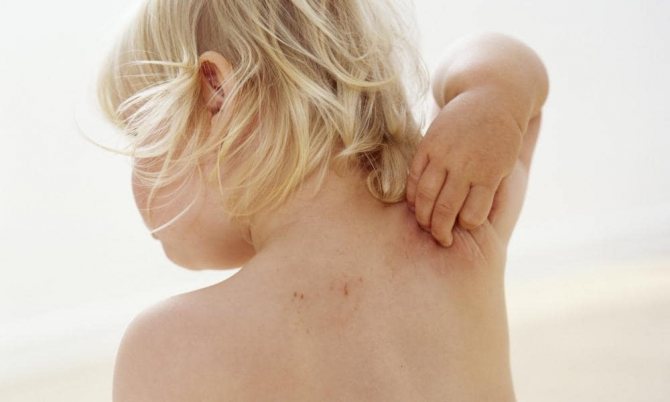
Atopic dermatitis is a prolonged allergic skin reaction. Characteristic signs are itching, scratching of the epidermis, blisters and weeping.
When infected, the lesion expands. The current is most often wavy.
With strophulus, the rash is in the form of dense red nodules, with itching. Sometimes pimples develop into a blister, which leaves brown crusts after healing.
Rashes due to diseases of the blood and blood vessels
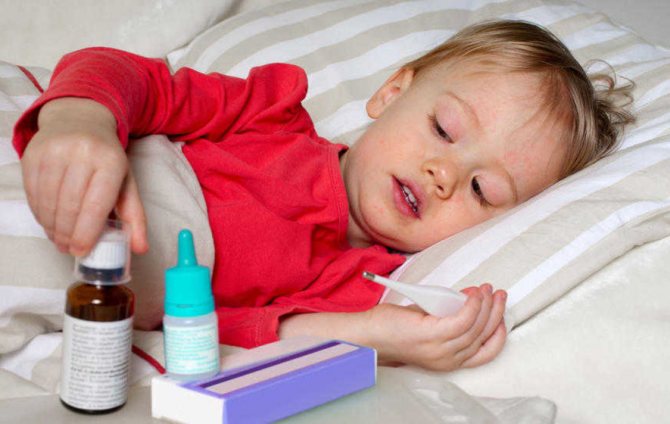
With these pathologies, a hemorrhagic rash in the form of small red spots becomes characteristic. This is a manifestation of hemorrhages into the skin of damaged blood vessels. They can occur due to increased permeability and a decrease in platelets.
The most common is hemorrhagic vasculitis, an inflammatory disease of the walls of microvessels. Usually occurs in children under 5 years of age. The affected areas seem flat, but to the touch the elements of the rash rise above the skin.
Self-treatment is impossible; it can only be done in a hospital. Children with this pathology are not advised to stay in the sun, physiotherapy, or sports.
Parental behavior
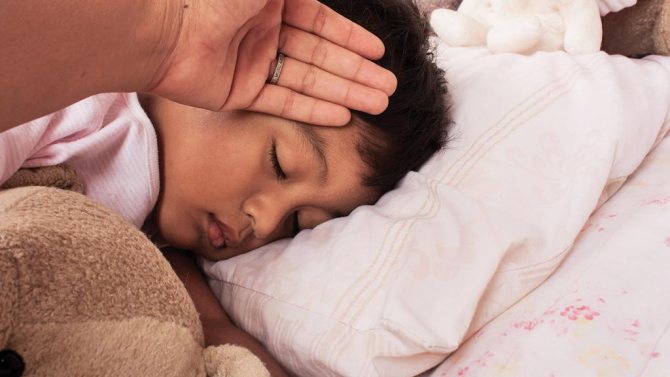
How to recognize the disease in a child with a rash on the back? Only a doctor can do this, even if you have incredible experience in caring for children, you cannot do this yourself.
If a rash appears, do not cover it with aniline dyes; call a doctor and isolate the child from contact with other family members.
A rash is a manifestation of internal disorders, and lubrication is a symptomatic measure. The cause will not go away, so seeing a doctor is necessary.
Treatment options
If there is a fever, the child should be seen by a doctor.
First of all, they treat the cause of acne on the back of a teenager or child and only then focus their efforts on eliminating external manifestations. However, in most cases, symptomatic therapy is not required, since after the elimination of the causative factor, the rash also disappears.
If the rash on the back is caused by increased sweating, which has led to the development of prickly heat, you can treat it at home. Particular attention is paid to skin hygiene. It is recommended to bathe the child 2 times a day in water with the addition of decoctions and infusions of medicinal herbs.
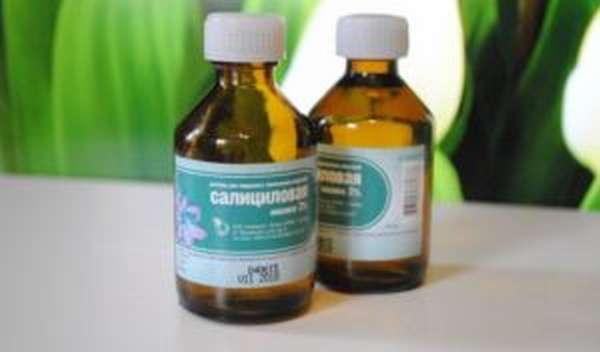
If the cause of the rash is an allergic reaction to a food product, you need to exclude it from the diet. If you are intolerant to powder, conditioner, or clothing material, it is important to remove the causative factor. For severe manifestations of an allergic reaction, antihistamines are prescribed.
Treating rashes at home, including with folk remedies, is not recommended in the following situations:
- the rash looks like subcutaneous hemorrhages, similar to varicose veins;
- there is vomiting or fever;
- the rash occurred in a child under 6 months of age;
- I have a headache or stomach ache at the same time.
Antibiotics are prescribed for bacterial infections
If skin symptoms are caused by exposure to viral pathogens, they are treated with antiviral drugs, and if the rash has a bacterial etiology, antibiotics are prescribed. If antihistamines do not relieve the symptoms of an allergic reaction, glucocorticoids are used.
Acne is removed with ointments, gels, treating tumors according to the scheme proposed by the attending physician or instructions. You can make lotions based on natural ingredients (herbs, plant extracts, etc.), iodine.
To increase the protective function of the body and speed up recovery, vitamins are prescribed.
